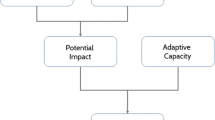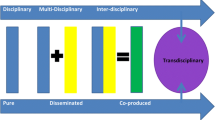Abstract
No matter one’s wealth or social position, all are subject to the threats of natural hazards. Be it fire, flood, hurricane, earthquake, tornado, or drought, the reality of hazard risk is universal. In response, governments, non-profits, and the private sector all support research to study hazards. Each has a common end in mind: to increase the resilience of vulnerable communities. While this end goal is shared across hazards, the conception of how to get there can diverge considerably. The earthquake and hurricane research endeavors in the US provide an illustrative contrast. The earthquake community sets out to increase resilience through a research process that simultaneously promotes both high quality and usable – preparedness-focused - science. In order to do so, the logic suggests that research must be collaborative, responsive, and transparent. Hurricane research, by contrast, largely promotes high quality science – predictions - alone, and presumes that usability should flow from there. This process is not collaborative, responsive, or transparent. Experience suggests, however, that the latter model – hurricane research - does not prepare communities or decision makers to use the high quality science it has produced when a storm does hit. The predictions are good, but they are not used effectively. Earthquake research, on the other hand, is developed through a collaborative process that equips decision makers to know and use hazards research knowledge as soon as an earthquake hits. The contrast between the two fields suggests that earthquake research is more likely to meet the end goal of resilience than is hurricane research, and thus that communities might be more resilient to hurricanes were the model by which research is funded and conducted to change. The earthquake research experience can provide lessons for this shift. This paper employs the Public Value Mapping (PVM) framework to explore these two divergent public value logics, their end results, and opportunities for improvement.




Similar content being viewed by others
References
Adger, Neil, Terry Hughes, Carl Folke, Stephen Carpenter, and Johan Rockström. 2005. Social-Ecological Resilience to Coastal Disasters. Science 309(5737): 1036–1039.
Bakun, William, and Allan Lindh. 1985. The Parkfield, California Earthquake Prediction Experiment. Science 229: 619–624.
Bijker, Wiebe E. 1993. Do Not Despair: There is Life After Constructivism. Science, Technology and Human Values 18(1): 113–138.
Bozeman, Barry. 2007. Public Values and Public Interest: Counterbalancing Economic Individualism. Washington, D.C.: Georgetown University Press.
Bozeman, Barry. 2002. Public Value Failure: When Efficient Markets May Not Do. Public Administration Review 62(2): 134–151.
Bozeman, Barry, and Daniel Sarewitz. 2005. Public Failure in Science Policy. Science and Public Policy 32(2): 119–136.
Bush, Vannevar. 1945. Science, the Endless Frontier. Washington, D.C.: N.S.F.R.t.P. Roosevelt. Office of Scientific Research and Development.
Byerly, Jr., Radford, and Roger Pielke. 1995. The Changing Ecology of United States Science. Science 269: 1531–1532.
Cash, David, and James Buizer. 2005. Knowledge-Action Systems for Seasonal to InterAnnual Forecasting: Summary of a Workshop. Washington, D.C.: National Academies Press.
Cash, David, William Clark, Frank Alcock, Nancy Dickson, Noelle Eckley, and Jill Jager. 2002. Salience, Credibility, Legitimacy, and Boundaries: Linking Research, Assessment, and Decision Making. Cambrige, MA: John F. Kennedy School of Government, Harvard University.
Cash, David, William Clark, Frank Alcock, Nancy Dickson, Noelle Eckley, Jill Jager, and Ronald Mitchell. 2003. Knowledge Systems for Sustainable Development. PNAS 100(14): 8086–8091.
Department of Commerce (DoC). 2006. “Hurricane Katrina Service Assessment Report.”
Earthquake Engineering Research Institute (EERI). 2008. Contributions of Earthquake Engineering to Protecting Communities and Critical Infrastructure from Multihazards. Oakland: EERI.
Eosco, Gina, Mark Shafer, Barry Keim, and Suzanne Van Cooten. 2009. “Lessons Learned: Evacuations Management of Hurricane Gustav.” American Meteorological Society Annual Meeting. Phoenix, AZ.
Flyvbjerg, Bent. 2001. Making Social Science Matter: Why Social Inquiry Fails and How It Can Succeed Again. Cambridge: Cambridge University Press.
Griliches, Zvi. 1995. R&D Productivity: Econometric Results and Measurement Issues. In The Handbook of the Economics of Innovation and Technological Change, ed. S. Paul. Oxford: Blackwell.
Guston, David. 2001. Boundary Organizations in Environmental Policy and Science: An Introduction. Science, Technology, and Human Values 26(4): 399–408.
Holling, Crawford Stanley. 1973. Resilience and stability of ecological systems. Annual Review of Ecology and Systematics 4: 1–23.
Hooke, William, and Roger Pielke Jr. 2000. Short Term Weather Prediction: An Orchestra in Need of a Conductor. In Prediction: Science, Decision Making, the Future of Nature, eds. Daniel Sarewitz, Roger Pielke Jr., and R. Byerly Jr. Washington, D.C.: Island Press.
Institute for Business and Home Safety (IBHS). 2009. “DisasterSafety.org homepage.” http://www.disastersafety.org/.
IBHS. 2005. “IBHS Broadens Mission in New Strategic Plan.” http://www.ibhs.org/publications/view.asp?cat=93&id=597.
Jacobs, Kathy. 2002. Connecting Science, Policy, and Decision Making: A Handbook for Researchers and Science Agencies. National Oceanic and Atmospheric Administration, Office of Global Programs.
JAG/TCR (Joint Action Group for Tropical Cyclone Research). 2007. Interagency Strategic Research Plan for Tropical Cyclones: The Way Ahead. Washington, D.C.: Office of the Federal Coordinator for Meteorology.
Klein, Richard J.T., Robert J. Nicholls, and Frank Thomalla. 2003. Resilience to natural hazards: how useful is this concept? Global Environmental Change Part B: Environmental Hazards 5(1–2): 35–45.
Latour, Bruno. 1998. From the world of science to the world of research? Science Magazine 280(5361): 208–209.
Lemos, Maria Carmen, and Barbara J. Morehouse. 2005. The Co-Production of Science and Policy in Integrated Climate Assessments. Global Environmental Change 15: 57–68.
Lindblom, C., and D. Cohen. 1979. Usable Knowledge: Social Science and Social Problem Solving. Yale University Press, New Haven.
Louisiana Department of Health and Hospitals. 2006. “Reports of Missing and Deceased.” April 18, 2006.
Ludwin, Ruth S., 2002, Cascadia Megathrust Earthquakes in Pacific Northwest Indian Myths, TsuInfo Alert, V. 4, No. 2, http://www.dnr.wa.gov/geology/tsuinfo/2002-02.pdf.
McElroy, Leslie. 2006. “ROI of a Visual Identity System at USGS.” CENDI Workshop.
Meade, Charles, and Megan Abbott. 2003. Assessing federal research and development for hazard loss reduction. Santa Monica: RAND Corporation.
Meade, Charles. 2004. Testimony to the Committee on Science of the US House of Representatives on Strengthening Research and Development for Wind Hazard Mitigation.
Mileti, Dennis, et al. 1999. Disasters By Design: A Reassessment of Natural Hazards in the United States. Washington, D.C.: Joseph Henry Press.
National Earthquake Hazards Reduction Program (NEHRP), 2006. NEHRP Strategic Plan.
NEHRP. 2008. Annual Report of the National Earthquake Hazards Reduction Program. Washington, D.C.
National Hurricane Center (NHC). 2008. “NHC Mission and Vision.” http://www.nhc.noaa.gov/mission.shtml.
National Oceanic and Atmospheric Administration (NOAA). 2008a. “Bush Administration More Than Quadruples 2009 Hurricane Forecast Improvement Budget Request to $17 Million.” http://www.noaanews.noaa.gov/stories2008/20080811_hurricanebudget.html.
NOAA. 2008b. “Proposed Framework for Addressing the National Hurricane Research and Forecast Improvement Initiatives.” NOAA Hurricane Forecast Improvement Project.
National Science and Technology Council (NSTC). 2008. Committee on Environment and Natural Resources Subcommittee on Disaster Reduction. Grand Challenges for Disaster Reduction. Washington, D.C.: NSTC.
National Science Foundation (NSF) 97-059. 1997. “NSF Funds Earthquake Research Centers in California, Illinois and New York.” http://www.nsf.gov/news/news_summ.jsp?cntn_id=102833.
Nigg, Joanne. 2000. "Predicting Earthquakes: Science, Pseudoscience, and Public Policy Paradox." In Prediction: Science, Decision Making, the Future of Nature. eds. Daniel Sarewitz, Roger Pielke Jr., and R. Byerly Jr., Washington, D.C.: Island Press.
Nowotny, Helga. 2007. How Many Policy Rooms Are There? Evidence-Based and Other Kinds of Science Policies. Science, Technology, and Human Values 32(4): 479–490.
NSB-06-115. National Science Board. 2007. Hurricane Warning: The Critical Need for a National Hurricane Research Initiative. Washington, D.C.
Pielke, Jr., Roger A., Laurens Bouwer, Ryan Crompton, Eberhard Faust, and Peter Höppe. 2008. “Catastrophe Losses in the Context of Demographics, Climate, and Policy.” Managing the Changing Landscape of Catastrophe Risk. 10th Aon Re Australia Biennal Hazards Conference, September 16–18 2007. Queensland Australia.
Pielke, Jr., Roger A. 2007. The Honest Broker: Making Sense of Science in Policy and Politics. Cambridge: Cambridge University Press.
P.L. 95-124. National Earthquake Hazards Reduction Act of 1977. 42 U.S.C. 7701 et. seq.
Shapiro, Ian. 2005. The Flight from Reality in the Human Sciences. Princeton: Princeton University Press.
Stokes, Donald. 1997. Pasteur’s Quadrant: Basic Research and Technological Innovation. Washington, D.C.: Brookings Institution Press.
Tobin, Graham A., and Burrell E. Montz. 2004. Natural hazards and technology: vulnerability, risk and community response in hazardous environments. In Brunn, S.D., S.L. Cutter, and J.W. Harrington, Jr. (Eds.) Technoearth: Geography and Technology. Dordrecht, Netherlands: Kluwer Academic Publishers. pp. 547–570.
Timmerman, Peter. 1981. Vulnerability, Resilience and the Collapse of Society. Environmental Monograph 1, Institute for Environmental Studies, Toronto University.
US Congress. 2006. Failure of Initiative: Final Report of the Select Bipartisan Committee to Investigate the Preparation for and Response to Hurricane Katrina. Washington, D.C.: Government Printing Office. http://www.gpoaccess.gov/katrinareport/fullreport.pdf.
US Geological Survey (USGS). 2008a. “Repeating Earthquakes.” Earthquake Hazards Program. http://earthquake.usgs.gov/research/parkfield/eq_predict.php.
USGS 2008b. “Parkfield, California, Earthquake Experiment.” Earthquake Hazards Program. http://earthquake.usgs.gov/research/parkfield/index.php.
USGS FS-087-03. 2003. “ShakeMap—A Tool for Earthquake Response.” U.S. Geological Survey Fact Sheet 087-03.
Weiss, Carol. 1995. The haphazard connection: Social science and public policy. International Journal of Educational Research 23(2): 137–150.
Winner, Langdon. 1996. The Gloves Come Off: Shattered Alliances in Science and Technology Studies. Social Text 46(47): 81–91.
Wynne, Brian. 2007. Dazzled by the Mirage of Influence? STS-SSK in Multivalent Registers of Relevance. Science, Technology, and Human Values 32(4): 491–503.
Young, Oran R. 2002. “Usable Knowledge: Design Principles and Institutional Diagnostics” in The Institutional Dimensions of Environmental Change: Fit, Interplay, and Scale. MIT Press, Cambridge, MA.
Author information
Authors and Affiliations
Corresponding author
Rights and permissions
About this article
Cite this article
Maricle, G.E. Prediction as an Impediment to Preparedness: Lessons from the US Hurricane and Earthquake Research Enterprises. Minerva 49, 87–111 (2011). https://doi.org/10.1007/s11024-011-9166-2
Published:
Issue Date:
DOI: https://doi.org/10.1007/s11024-011-9166-2




